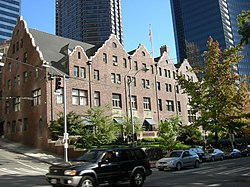
Cutter & Malmgren was an architectural firm of Kirtland K. Cutter and Karl G. Malmgren in Spokane, Washington that existed from c.1889 to 1917. The firm designed multiple buildings that are listed on the U.S. National Register of Historic Places.
The firm was founded in c.1889 by Cutter and John Poetz as Cutter & Poetz. Upon Poetz's retirement, it was reorganized as Cutter & Malmgren. The partnership closed in 1917, after which Cutter continued in individual practice. [1]
